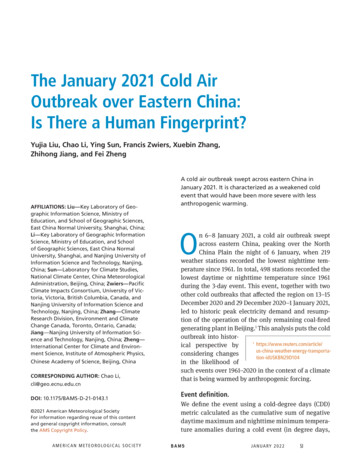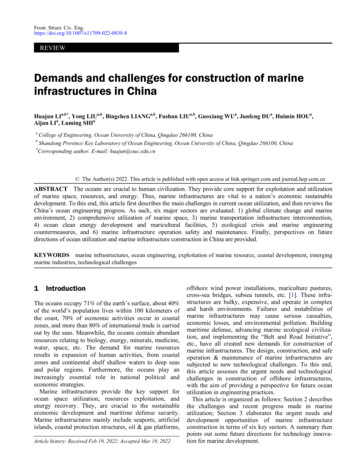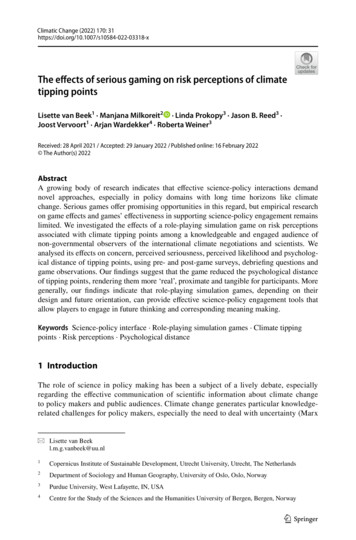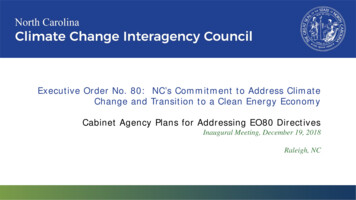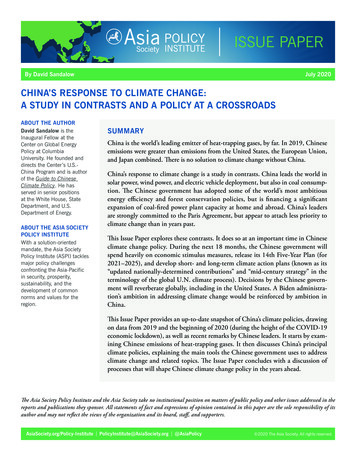
Transcription
ISSUE PAPERBy David SandalowJuly 2020CHINA’S RESPONSE TO CLIMATE CHANGE:A STUDY IN CONTRASTS AND A POLICY AT A CROSSROADSABOUT THE AUTHORDavid Sandalow is theInaugural Fellow at theCenter on Global EnergyPolicy at ColumbiaUniversity. He founded anddirects the Center’s U.S.China Program and is authorof the Guide to ChineseClimate Policy. He hasserved in senior positionsat the White House, StateDepartment, and U.S.Department of Energy.ABOUT THE ASIA SOCIETYPOLICY INSTITUTEWith a solution-orientedmandate, the Asia SocietyPolicy Institute (ASPI) tacklesmajor policy challengesconfronting the Asia-Pacificin security, prosperity,sustainability, and thedevelopment of commonnorms and values for theregion.SUMMARYChina is the world’s leading emitter of heat-trapping gases, by far. In 2019, Chineseemissions were greater than emissions from the United States, the European Union,and Japan combined. There is no solution to climate change without China.China’s response to climate change is a study in contrasts. China leads the world insolar power, wind power, and electric vehicle deployment, but also in coal consumption. The Chinese government has adopted some of the world’s most ambitiousenergy efficiency and forest conservation policies, but is financing a significantexpansion of coal-fired power plant capacity at home and abroad. China’s leadersare strongly committed to the Paris Agreement, but appear to attach less priority toclimate change than in years past.This Issue Paper explores these contrasts. It does so at an important time in Chineseclimate change policy. During the next 18 months, the Chinese government willspend heavily on economic stimulus measures, release its 14th Five-Year Plan (for2021–2025), and develop short- and long-term climate action plans (known as its“updated nationally-determined contributions” and “mid-century strategy” in theterminology of the global U.N. climate process). Decisions by the Chinese government will reverberate globally, including in the United States. A Biden administration’s ambition in addressing climate change would be reinforced by ambition inChina.This Issue Paper provides an up-to-date snapshot of China’s climate policies, drawingon data from 2019 and the beginning of 2020 (during the height of the COVID-19economic lockdown), as well as recent remarks by Chinese leaders. It starts by examining Chinese emissions of heat-trapping gases. It then discusses China’s principalclimate policies, explaining the main tools the Chinese government uses to addressclimate change and related topics. The Issue Paper concludes with a discussion ofprocesses that will shape Chinese climate change policy in the years ahead.The Asia Society Policy Institute and the Asia Society take no institutional position on matters of public policy and other issues addressed in thereports and publications they sponsor. All statements of fact and expressions of opinion contained in this paper are the sole responsibility of itsauthor and may not reflect the views of the organization and its board, staff, and supporters.AsiaSociety.org/Policy-Institute PolicyInstitute@AsiaSociety.org @AsiaPolicyAsiaSociety.or g/Policy-Ins titute PolicyInstitute@AsiaSociety.org @AsiaPolicy 2020 The Asia Society. All rights reserved.
ISSUE PAPERChina’s share ofglobal emissions hasbeen in the rangeof 24 percent—27percent, trendingmostly upward, forthe past decade.EMISSIONS OF HEAT-TRAPPING GASES(CO 2 E) 2019CUMULATIVE CO 2 EMISSIONS1751 TO 201914%27%13%39%26%38%8%3% 4%6%22%ChinaIndiaJapanChinaEuropean UnionUnited StatesRussiaRest of WorldUnited StatesRest of WorldEuropean UnionSource: Climate Action Tracker 1Sources: Our World in Data, BPBACKGROUND:CHINA’S EMISSIONS OFHEAT-TRAPPING GASES ** The principal heat-trappinggases—also commonly referredto as “greenhouse gases”—are carbon dioxide (CO2),methane (CH4), nitrousoxide (NOx) and fluorinatedgases (such as HFCs). Ofthese, CO2 is by far the mostimportant, with roughly 76percent of the total warmingimpact of these gases globally.See Intergovernmental Panelon Climate Change (IPCC)Working Group III, ClimateChange 2014: Mitigation ofClimate Change—Summaryfor Policymakers (FifthAssessment Report) at p. 6.In 2019, roughly 27 percent of the heattrapping gases emitted globally came fromChina—far more than from any othernation. The United States was second, withapproximately 13 percent of global emissions. China’s share of global emissionshas been in the range of 24 percent—27percent, trending mostly upward, for thepast decade.2However, annual emissions are not the onlyway to measure contributions to climatechange. China’s cumulative emissions ofCO2 during the past several centuries are14 percent of the global total—roughlyhalf those of the United States. (CO2 oftenstays in the atmosphere for centuries afterbeing emitted.)3China’s per capita CO2 emissions today arealso less than half those of the United States(though more than Europe’s).4CO 2 EMISSIONS PER CAPITA 201918.015.0Sources: BP, United Nations15.112.08.99.06.96.04.53.01.81.00.0United StatesJapanChinaChina’s Response to Climate Change: A Study in Contrasts and a Policy at a CrossroadsEurope (EU)IndiaAfricaPage 2
ISSUE PAPERCHINA’S CO 2 EMISSIONS FROM FOSSIL FUELS (GT) AND CHINA'S GDP(TRILLION USD) 1985–2020Sources: BP, CICERO, Rhodium Group, IEA, World Bank13.515EmissionsGDP9.5105.550.0019819 58619819 7819 8819 9919 0919 1919 2919 3919 4919 5919 6919 7919 8920 9020 0020 1020 2020 3020 4020 5020 6020 7020 8020 9120 0120 1120 2120 3120 4120 5120 6120 7120 8120 920GT / TRILLION USDIn the first quarterof 2020, as muchof China waslocked down due toCOVID -19, China’sCO2 emissions fellroughly 8 percent.From 1985 through 2011, Chinese GDPand CO2 emissions tracked closely.† Startingin 2011, GDP and CO2 emissions startedto decouple, with GDP rising an averageof 7.5 percent per year and CO2 emissionsrising an average of 1.5 percent per year.5that China would “tak[e] the driving seatin international cooperation to respondto climate change.” There are no knownclimate deniers in the Chinese leadership—and none with any observable influence onpolicy.7In the first quarter of 2020, as much ofChina was locked down due to COVID19, China’s CO2 emissions fell roughly8 percent. China’s GDP fell roughly 6.8percent during the same period—the firstquarterly drop in GDP in at least 40 years.6However, the priority Chinese leaders attachto climate change appears to have recededin the past year. On several occasions,top leaders have called for developmentof China’s coal resources (which couldsignificantly increase emissions) withoutmentioning low-carbon development orclimate change. Examples include remarksby Premier Li Keqiang at an October2019 meeting of the National EnergyCommission and the May 2020 NationalPeople’s Congress. The latter may be especially notable, since Premier Li had referredto climate change in his remarks to theNational People’s Congress in years past.Approvals of new coal plant constructionhave increased in 2020, as discussed later.8CHINA’S CLIMATEPOLICIES TODAY†The two data sets have acorrelation coefficient of .95.President Xi Jinping and other Chineseleaders have often sent the message thatthey are serious about addressing climatechange. In 2014, President Xi said, “addressing climate change and implementation ofsustainable development is not what we areasked to do, but what we really want to doand will do well.” In 2017, President Xi saidChina’s Response to Climate Change: A Study in Contrasts and a Policy at a CrossroadsPage 3
ISSUE PAPERIn March 2020, theChinese governmentapproved theconstruction of 8GW of new coalfired power plantcapacity—moreapprovals than in allof 2019.Observers have pointed to a number offactors to explain this shift, includingslowing economic growth, a focus onenergy security (in part due to the U.S.China trade war), and then COVID-19.They have also noted that renewable energy,electric vehicles, and other low-carbontechnologies continue to receive attention from Chinese leaders. Several policyprocesses in the year ahead will provideimportant signals about the priority China’sleaders attach to low-carbon developmentand climate change.9The sections below discuss Chinese policiesmost directly related to climate change.(For a more detailed discussion of thesepolicies and others, see the Guide to ChineseClimate Policy.)Climate GoalsThe Chinese government has announcedfour principal climate change goals:I. to achieve the peaking of carbon dioxideemissions around 2030, making bestefforts to peak early;II. to lower carbon dioxide emissions perunit of GDP by 60 percent–65 percentfrom the 2005 level by 2030;III. to increase the share of non-fossilfuels in primary energy to around 20percent by 2030; andIV. to increase the forest stock volume byaround 4.5 billion cubic meters from2005 levels by 2030.‡As of the end of 2019,China’s CO2 emissions perunit of GDP were roughly52 percent below 2005 levelsand non-fossil fuels accountedfor 14.9 percent of primaryenergy.These goals were set out in the NationallyDetermined Contributions (NDCs) Chinasubmitted to the UN Framework Convention on Climate Change (UNFCCC)in June 2015 and have been highlighted inmany official documents since.10China’s Response to Climate Change: A Study in Contrasts and a Policy at a CrossroadsChina is on track to meet all these goals.In fact, many analysts project that Chinais likely to achieve the first goal—to peakCO 2 emissions—well before 2030. Thesecond and third goals both appear to beachievable based on current trends.‡ Andthe fourth goal was met in 2019—11 yearsahead of schedule.11These goals are pursued through a policyinfrastructure that includes Five-YearPlans, regulations, guidance documents,and financial support. One common toolis to allocate targets to provinces. China’sNational Development and ReformCommission (NDRC) and NationalBureau of Statistics report annually onprogress toward these goals.12CoalIn 2019, China consumed more coal thanthe rest of the world combined. More than20 percent of global CO2 emissions werefrom Chinese combustion of coal. China’scoal policies are central to the global fightagainst climate change.13Coal consumption as a share of primaryenergy consumption has declined steadily inChina for many years, falling most recentlyfrom 62.0 percent in 2016 to 60.4 percent in2017 to 59.0 percent in 2018 to 57.7 percentin 2019, according to official statistics.14Substantial construction of new coal-firedpower plant capacity continues in China,with 30 GW–37 GW of net new capacityadded in 2019 and another 100 GW underconstruction as of March 2020. In March2020, the Chinese government approvedthe construction of 8 GW of new coal-firedpower plant capacity—more approvals thanin all of 2019.15The Chinese government has a number ofpolicies that discourage coal consumption.Page 4
ISSUE PAPERThe 14th Five-YearPlan targets withrespect to coal-firedpower plant capacitywill be one of themost closely watchedindicators of theChinese government’scommitment tofighting climatechange.These include: Five-Year Plan targets to reduce coal as ashare of primary energy; massive investment in switching fromcoal to natural gas for heating in northern China; C O 2 emissions standards for powerplants; and a central government “stoplight system”to regulate new coal plant approvals.At the same time, the Chinese governmentalso has a number of policies that encouragecoal consumption. These include: guaranteed operating hours for coalplants; cheap capital for coal power plants fromstate-owned banks; and traditional promotion criteria for provincial officials, which weight shortterm GDP growth over environmentaltargets, often giving an incentive toapprove coal-fired power plants withlimited long-term value.In his remarks at the May 2020 NationalPeople’s Congress, Premier Li Keqiangsaid, “We will promote cleaner and moreefficient use of coal.” He did not mentioncutting overcapacity in coal or reducingcoal’s share of primary energy consumption, two goals that have received attentionin government policy pronouncements inyears past.16Coal-fired power plant capacity in Chinatoday is roughly 1040 GW. The cap underthe 13th Five-Year Plan, which runsthrough the end of 2020, is 1100 GW.The China Electricity Council and ChinaState Grid have both proposed allowingup to 1300 GW of coal-fired power plantcapacity by 2030. The 14th Five-Year Plantargets with respect to coal-fired powerplant capacity will be one of the mostclosely watched indicators of the ChineseCHINESE COAL POWER PLANT CAPACITY 2000-20191,200Source: Carbon Brief1,000GW800600400200China’s Response to Climate Change: A Study in Contrasts and a Policy at a 20092008200720062005200420032002200120000Page 5
ISSUE PAPERIn 2019, renewablesprovided roughlya quarter of theelectricity inChina—18 percentfrom hydropower,5.5 percent fromwind, and 3 percentfrom solar.government’s commitment to fightingclimate change.17Renewable PowerChina leads the world in deployment ofrenewable power, with almost three timesas much capacity as any other nation. In2019, 36 percent of the renewable powercapacity added globally was in China (downfrom 42 percent in 2018 and the lowest thisfigure has been in several years).18Hydropower has been a significant electricity source in China for decades. Windand solar power have grown dramaticallyin the past decade. In 2019, renewablesprovided roughly a quarter of the electricityin China—18 percent from hydropower, 5.5percent from wind, and 3 percent from solar.This was almost the same share as in 2018.19The Chinese government is in the processof significantly changing its renewablepower polices. Feed-in tariffs—which havebeen central to the Chinese wind and solarindustries for the past decade—are beingphased out and replaced with auctionsand “renewable electricity consumptionquotas” (which require grid companies topurchase minimum amounts of renewableelectricity).Premier Li Keqiang called for developmentof China’s renewable energy resources inhis October 2019 remarks to the NationalEnergy Commissions and May 2020speech to the National People’s Congress.20nation’s hydropower capacity. Work onthe Three Gorges Dam—the world’slargest hydropower project—began inthe 1980s. The dam became fully operational in 2012, with a capacity of 22.5GW.22Wind PowerAs of the end of 2019, China had 210GW of wind power capacity—morethan twice as much as any other nation.In recent years, China has consistentlyled the world in new wind power installations. In 2019, 26 GW of new windpower capacity was added in China—a28 percent increase in new installationsfrom the year before.23Curtailment is a challenge for theChinese wind power industry, althoughthe situation has improved significantlyin recent years. In 2019, China’s windpower curtailment rate was 4 percentnationally (down significantly from 15percent in 2015).24Solar PowerAs of the end of 2019, China had roughly205 GW of solar power capacity—morethan three times as much as any othernation. In recent years, China hasconsistently led the world in new solarpower deployment. In 2019, 30 GW ofnew solar power capacity was added inChina—a 32 percent decrease in newinstallations from the year before.25HydropowerAs of the end of 2019, China hadroughly 356 GW of hydropowercapacity—more than three times asmuch as any other nation.21China also leads the world in solarmanufacturing, as it has for each of thepast 10 years. In 2019, Chinese firmsshipped roughly 80 percent of the solarcells and modules shipped by the world’stop 10 suppliers.26The Chinese government has a longstanding commitment to expanding theIn 2019, solar power curtailment inChina was roughly 2 percent nationally.27China’s Response to Climate Change: A Study in Contrasts and a Policy at a CrossroadsPage 6
ISSUE PAPERIn the first quarterof 2020, as Chinesepower generation fellroughly 8 percentyear-over-year dueto the coronavirus,solar generation inChina increased by12 percent.CHINA ELECTRIC POWER GENERATIONChange from Jan/Feb 2019 to Jan/Feb 2020Source: National Bureau of 0%-8.9%-11.9%-15.0%Thermal PowerHydro PowerNuclear PowerIn the first quarter of 2020, as Chinesepower generation fell roughly 8 percentyear-over-year due to the coronavirus,solar generation in China increased by 12percent. This was due to the 30 GW ofnew solar capacity added in 2019 as wellas renewable energy electricity quotas.28CO2 Emissions Trading ProgramThe Chinese central government is in theprocess of launching a national CO2 emissions trading program, building on pilotprojects in eight Chinese cities and provinces. The first phase of this program willcover the power sector. When fully implemented, the national program will coverapproximately 5 Gt of annual emissions—far more than any other emissions tradingprogram in the world. However, the extent towhich emissions trading will reduce China’semissions of heat-trapping gases is unclear.29The Chinese government first announcedplans to develop a domestic CO2 emissions trading program in 2011. Over thenext several years, pilot programs wereChina’s Response to Climate Change: A Study in Contrasts and a Policy at a CrossroadsWind PowerSolar Powerlaunched in Beijing, Shanghai, Chongqing,Shenzhen, Hubei, Tianjin, Guangdong,and Fujian. In September 2015, PresidentXi Jinping announced plans to launch anational CO2 emissions trading program.Implementation of China’s national CO2emissions trading program has proceededslowly. Delays have been due to dataavailability challenges, government reorganization, the inherent complexity ofemissions trading programs and—mostrecently— COVID-19. 30 As of today,central elements of the program remainunclear. Those elements include the CO2emissions levels that will be allowed underthe program, enforcement mechanisms,and the relationship between the programand power sector reform. Decisions onthese and other items will determine theimpact of emissions trading on China’sCO2 emissions in the years ahead.31Urban Air PollutionSevere air pollution chokes many Chinesecities. Soot and smog levels exceed nationalPage 7
ISSUE PAPERThe number of dayswith good andabove air quality inChina’s largest citiesincreased 7 percentduring the firstquarter of 2020 ascompared to thesame period in 2019.and international health standards, oftenby wide margins. In recent years, these airpollution levels have been falling steadily.According to official statistics, averagePM2.5 levels in many large Chinese citieshave fallen by a third to a half since 2013.32During the first quarter of 2020, as muchof China was shut down due to the coronavirus, emissions of some air pollutantsdropped sharply. Average SO2 concentrations fell 21 percent as compared to thefirst quarter of 2019. However, other airpollutants fell less sharply, in part becausemany major industrial facilities continuedto operate during the lockdown. Thenumber of days with good and above airquality in China’s largest cities increased 7percent during the first quarter of 2020 ascompared to the same period in 2019.33to long-term decarbonization of the transport sector.Some technologies for controlling urbanair pollution are counterproductive when itcomes to global warming. Scrubbers on coalplants have important local air pollutionbenefits but increase CO2 emissions slightlysince scrubbers require energy to operate.More significantly, synthetic natural gas canhelp reduce urban air pollution by movingcoal combustion from urban to rural areasbut significantly increases CO2 emissions.VehiclesVehicles produce roughly 8 percent of theheat-trapping gases emitted in China eachyear. Vehicles also contribute significantlyto urban air pollution in China (althoughless than coal combustion in most cities).34Air pollution is a top concern of manyChinese citizens and China’s leaders.President Xi Jinping promises to “makeChina’s skies blue again” and identifiescutting pollution as one of three priority“tough battles” for China in the years ahead.China’s 13th Five-Year Plan (2016–2020)gives priority to fighting air pollution,setting quantitative goals for air pollutionreduction.In 2019, 25.8 million new motor vehicleswere sold in China—more than in anyother country by far. Sales fell 8 percentyear-over-year. The average fuel economy ofnew passenger cars sold in China in 2019was roughly 5.8 liters per 100 kilometers (equivalent to roughly 40.5 miles pergallon). This is better average fuel economythan in the United States and Australia, butworse than in Europe and Japan.35Most measures to fight urban air pollutionin China also help fight climate change.Policies that promote solar, wind, hydro, andnuclear power as alternatives to coal reduceboth local air pollutants and heat-trappinggases. So do policies that promote energyefficiency. Policies that promote natural gasas an alternative to coal help reduce local airpollution by 90 percent or more and CO2emissions by roughly 50 percent, providedthe natural gas does not leak. Policies topromote electric vehicles provide significantlocal air pollution benefits and are essentialIn 2019, 1.2 million plug-in electric vehicles(EVs) were sold in China—more thanin the rest of the world combined. Salesincreased 7 percent year-over-year. Morethan 98 percent of the roughly 500,000electric buses in the world are in China.36China’s Response to Climate Change: A Study in Contrasts and a Policy at a CrossroadsAs China reopens from COVID-19 lockdowns, commuting patterns have shiftedsharply. For example, in April 2020,urban mass transit use in China was down50 percent from April 2019. Meanwhiletraffic in some Chinese cities increased 10Page 8
ISSUE PAPERIn his May 2020speech to theNational People’sCongress, PremierLi Keqiang identifiedinvestment in EVcharging infrastructureand promotinggreater use of newenergy vehicles aseconomic stimuluspriorities of theChinese government.percent–50 percent from the same period lastyear. Whether this shift will persist is unclear.In May 2020, sales of new motor vehiclesin China showed a monthly year-over-yearincrease for the first time in two years.37The Chinese government’s principal policieswith respect to vehicle emissions includefuel efficiency standards and support for“new energy vehicles.” Almost all newenergy vehicles in China today are plug-inelectric vehicles with batteries, althoughfuel cell electric vehicles are receivinggrowing attention from policymakers.All vehicle manufacturers in China mustmeet fuel efficiency standards; however,enforcement of the standards is uneven.Some experts report that manufacturersface few penalties for failing to comply.38The Chinese government strongly supportsplug-in EVs. Central government policiesinclude a target of 5 million electricvehicles on China’s roads by 2020, EVquotas for vehicle manufacturers andimporters, manufacturing subsidies, bonuscredits to auto manufacturers in meetingfuel efficiency standards, tax exemptions,government procurement, and support forthe construction of electric vehicle chargingstations. Many provincial and municipalgovernments also support electric vehicles,with preferential access to license plates andother incentives.39In the first half of 2020, the central government and many provinces adopted policiesto promote EVs, including extendedpurchase subsidies and additional licenseplate quotas. In his May 2020 speech tothe National People’s Congress, PremierLi Keqiang identified investment in EVcharging infrastructure and promotinggreater use of new energy vehicles as eco-China’s Response to Climate Change: A Study in Contrasts and a Policy at a Crossroadsnomic stimulus priorities of the Chinesegovernment.40Nuclear PowerChina has 48 nuclear power plants—thethird-largest fleet in the world, behind onlythe United States and France. Of the 13nuclear power plants in the world openedin 2018 and 2019, 9 were in China. In2019, nuclear power provided roughly 4.6percent of China’s electricity, up from 4.0percent in 2018 and 3.8 percent in 2017.41The Chinese government has ambitiousplans to expand China’s nuclear-generatingcapacity. However, construction has notkept pace with the goals in the 13th FiveYear Plan (2016–2020), which calls for 58GW of installed nuclear power capacityand an additional 30 GW under construction by 2020. As of June 2020, China had48 GW of installed nuclear power capacityand roughly 12 GW under construction.42The Chinese government supports thedevelopment of nuclear power with anumber of policy tools. These include: favorable prices and allocations ofoperating hours for electricity sales; cheap debt capital for the large stateowned enterprises (SOEs) that operateChina’s nuclear power plants; and help assembling land and arranging fortransmission connections at new nuclearpower plant sites.43In building its nuclear power fleet, Chinahas imported technology from the UnitedStates (AP1000), Canada (CANDU), Russia(VVER), and France (M310 and EPR). TheChinese government aims to localize thesetechnologies and become self-sufficient inreactor design and construction.Page 9
ISSUE PAPERPBoC’s Green BondEndorsed ProjectCatalogue includes“clean utilization ofcoal” as an eligibleproject category.If each nuclear plant in China displaces acoal-fired power plant that might have beenbuilt in its place, then avoided emissionsfrom China’s nuclear fleet in 2019 wouldbe roughly 336 million tons of CO2 peryear—roughly 3 percent of China’s CO2emissions and almost 1 percent of globalCO2 emissions.44HFCsHydrofluorocarbons (HFCs) are humanmade chemicals used in refrigeration and airconditioning. They were introduced in thelate 1980s to replace chlorofluorocarbons(CFCs) and other chemicals that were damaging the ozone layer. HFCs do not damagethe ozone layer; however, both HFCs andCFCs are powerful heat-trapping gases.China is the world’s largest producer andconsumer of HFCs, as well as the largestproducer of refrigerators and air conditioners. Under the 13th Five-Year Plan, theChinese government is working to reduceHFC production capacity and promotingHFC alternatives including R290 forrefrigeration and space cooling.45In 2016, China joined 196 other countriesin adopting the Kigali Amendment to theMontreal Protocol on Substances ThatDeplete the Ozone Layer, agreeing to peakproduction and consumption of HFCs by2028, with reductions ultimately reaching85 percent by 2045.46CFC production is illegal in China.Nevertheless, several recent studies suggestthat new CFC production continues inseveral provinces. Chinese authorities stresstheir determination to stop this illegalproduction.47Green FinanceThe Chinese government strongly promotes“green f inance,” which China’s centralChina’s Response to Climate Change: A Study in Contrasts and a Policy at a Crossroadsbank (the People’s Bank of China orPBoC) defines as “financial servicesprovided for economic activities that aresupportive of environmental improvement,climate change mitigation and more efficient resource utilization.” In September2016, PBoC promulgated Guidelines forEstablishing the Green Financial System—the first central bank to issue green financeguidelines.48China’s green finance policies promoteinvestment in a wide range of assets,including renewable energy projects, watertreatment plants, recycling facilities, andmass transit. In 2019, China’s green financepolicies helped mobilize in the range ofRMB 240 billion to RMB 280 billion ( 34billion to 40 billion) of green bonds forqualifying projects.49PBoC’s Green Bond Endorsed ProjectCatalogue includes “clean utilizationof coal” as an eligible project category.During the first half of 2019, accordingto one report, Chinese financial institutions provided more than 1 billion to coalprojects that qualified as green financingunder Chinese standards. Internationalstandards for green bond investments donot include coal projects among the eligiblecategories.50ForestryForests cover large parts of southern China,from Fujian Province in the east to Sichuanand Yunnan Provinces in the west. Forestsalso cover much of China’s far northeast.Roughly 23 percent of China’s territory iscovered with forests.51China’s forest cover has expanded in recentdecades, according to a number of sources(although at least one source finds netforest loss). Forest stock density may beincreasing in China as well.52Page 10
ISSUE PAPERChina’s forestprograms sequestersignificant amountsof carbon. Estimatesvary, with differentstudies suggestingfigures in the rangeof 5 percent–11percent of annualCO2 emissions.CHINA’S FOREST COVERSource: Lei Shi et al. (2011)FOREST TYPESConiferous forestBroad leaved forestMixed coniferous and broadleaved forestChina’s Natural Forest ConservationProgram is the largest forest conservationprogram in the world. It includes massivetree-planting programs, an expansion offorest reserves, and a ban on logging inprimary forests. The Chinese governmentspends heavily on these forest programs—more than either the United States orEurope and more than three times theglobal average per hectare.53China’s Nationally Determined Contributions gives high prominence to a forestgoal—“to increase the forest stock volumeby around 4.5 billion cubic meters from2005 levels by 2030.” In July 2019, PremierLi Keqiang announced that China had metthis goal 11 years ahead of schedule.54China’s forest programs sequester significant amounts of carbon. Estimates vary,China’s Response to Climate Change: A Study in Contrasts and a Policy at a Crossroadswith different studies suggesting figures inthe range of 5 percent–11 percent of annualCO2 emissions.55Some of China’s forest policies andconsumption patterns may exacerbatedeforestation in other countries, offsettingthe climate benefits of the carbon sequestered in China’s forests. Although theChinese government has expanded forestreserves and banned logging in China’
China is the world's leading emitter of heat-trapping gases, by far. In 2019, Chinese emissions were greater than emissions from the United States, the European Union, and Japan combined. There is no solution to climate change without China. China's response to climate change is a study in contrasts. China leads the world in
